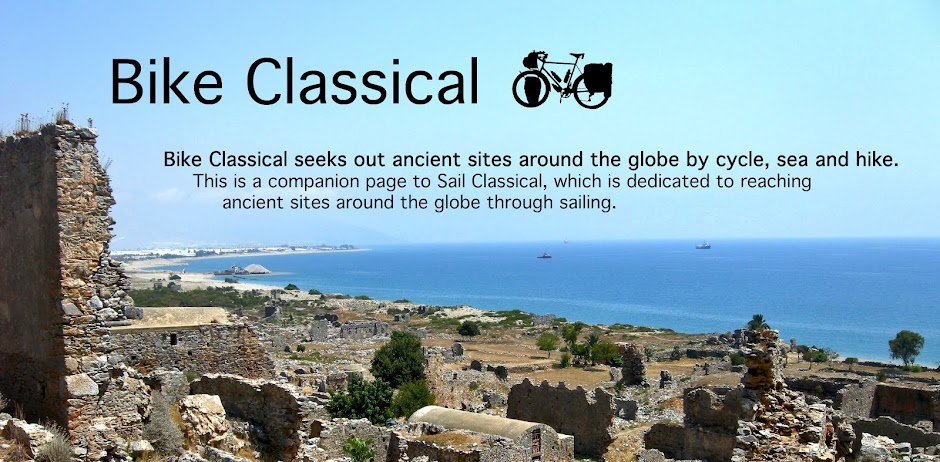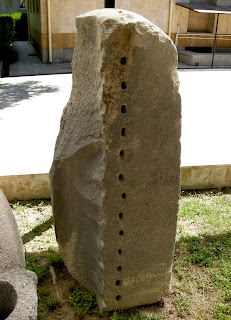Photos by Jack A. Waldron
With Mount Erciyes, or, Mount Argaeus as it was known in ancient times (pictured in the distance in the photo above), being a constant in the scenic element of the landscape south of Kayseri, I began my journey to Nigde (pronounced Nih-day). For the Hittites, the city was settled as Nahita or Naxita, and for the ancient Greeks, it was Nihda. Regardless of who has controlled this area, whether the Assyians, Phrygians, Greeks, Armenians, Persians, Hellens, Romans, Byzantines, etc., Nigde sits at the center of many crossroads that connect the far corners of Anatolia.
As I cycled the plateau that rises from the valley south of Mount Erciyes, I was overtaken by the serenity and calm. There were such magnificent fields of wild flowers, that it became difficult to cycle onward without taking the time to really appreciate the miracle of our planet.
I'll refer to this section of the post as 'the selfie-perspective exhibit'! The selfie gives some context and size comparison, which I find helps the viewer. My thinking typically contemplates using one photo out of a group of photos, such as these. But here, all of these flowers were just so wonderful, I have to include this whole group of selfies. Sorry!!
If you are knowledgeable with regard to these flower types, feel free to tell us in the comment section below.
As I write this, I'm trying to think of a clever song that contains a number of flower names in the lyrics, but I can only come up with "Ring a Ring o' Roses"!
It never ceases to amaze people that someone would ride a bicycle up and around mountains, over hot deserted plains, or deal with the traffic of cities, but if they only knew the free feeling a simple two-wheeled non-motorized transport can offer! In the Disneyland of ancient cities, the thrill lasts longer than any amusement park ride, in my humble opinion.
If there are any ancient remains within the city center of Nigde, they were destroyed, quarried, or built over long long ago. There are however some post-Byzantine monuments that have survived and been restored. The Hudavent Hatun Mausoleum is one of them (pictured below).
I wrote extensively about post-Byzantine rule over the area of greater Kayseri in my post titled, 'Caesarea Mazaka: Part II', so I encourage you to give it a read, as period was quite fractured, turbulent, as well as disruptive.
When I look at the intricate geometrical reliefs of the Islamic style, I see a direct lineage with Byzantine style relief.
Pictured below, this Byzantine column with inlaid colored stone and geometrical pattern can be found in the Istanbul Archeological Museum.
I saw a number of such tomb structures during my time in Erzurum, but I didn't take any photos of them, because I never thought I would be interested in post-Roman history, but as I've traveled, the Byzantine era and later have entered my interests.
The Nigde Archeological Museum courtyard, like most museum courtyards around Turkey, are home to countless unmarked treasures, such as the relief pictured below.
This particular relief, showing a male figure carrying bunches of grapes, looks suspiciously Phrygian to me, with the elevated sloping cap and turned up horn toed footwear, though Hittite reliefs also show similar footwear.
How do you crack a block of stone to create a flat slab so that you might sculpt a relief on its face? Better yet, how do you drill holes into a slab of stone circa 1200 BCE?
Pictured above, a bull being attacked by a lion, whose paw you can see clawing the bovines head over its back from behind. More Roman eagles (pictured below).
Every museum in Turkey seems to be flush with stone sculptures of eagles. The birds of prey were also a favorite subject of the Commagene culture, whose kingdom was absorbed into the Roman Empire.
My grandmother had a Virgin Mary statue on her front lawn, as many Catholic households did back in the day. I guess these birds of prey played a similar role?
So, with regard to the main attraction in the city center of Nigde (at least for antiquities nuts like myself), it is the Nigde Archeological Museum.
Within this particular post, I've only provided a few of the photos that I shot there, but there will be plenty more in my posts on ancient Tyana, Gumusler Monastery and more.
Since there are few ancient attractions within the city center of Nigde, I decided to provide some information regarding the coinage of ancient times.
There is a nice collection of coins at the museum, but unfortunately, my old camera has always struggled to get clear close-ups.
I did manage to get a couple of decent shots of coins, which you can see at the bottom of this post.
Pictured below, two coins that represent a massive amount of history regarding the area known in ancient times and present, as Cappadocia.
*All photos and content property of Jack A. Waldron (photos may not be used without written permission)
**If you'd like to help with future postings, please feel free to support them through PATREON:


























